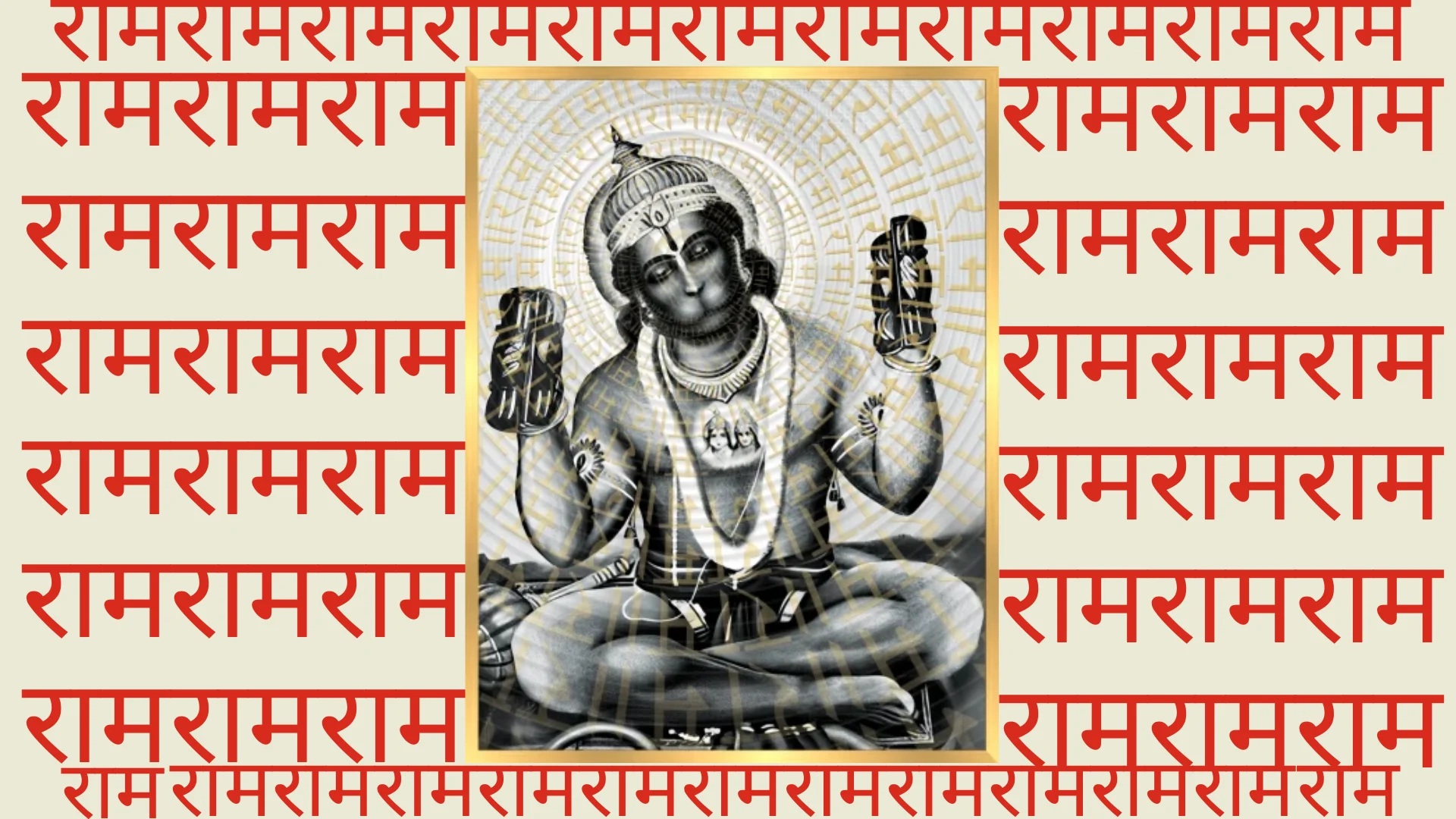What is the Hanuman Mantra?
The Om Hum Hanumate Namah mantra is dedicated to the great Rama devotee Hanuman or Lord Anjaneya. Know that Lord Anjaneya is the mediator towards your Ishta Devata. Hence he is also known as Ram doot. Here doot means messenger.
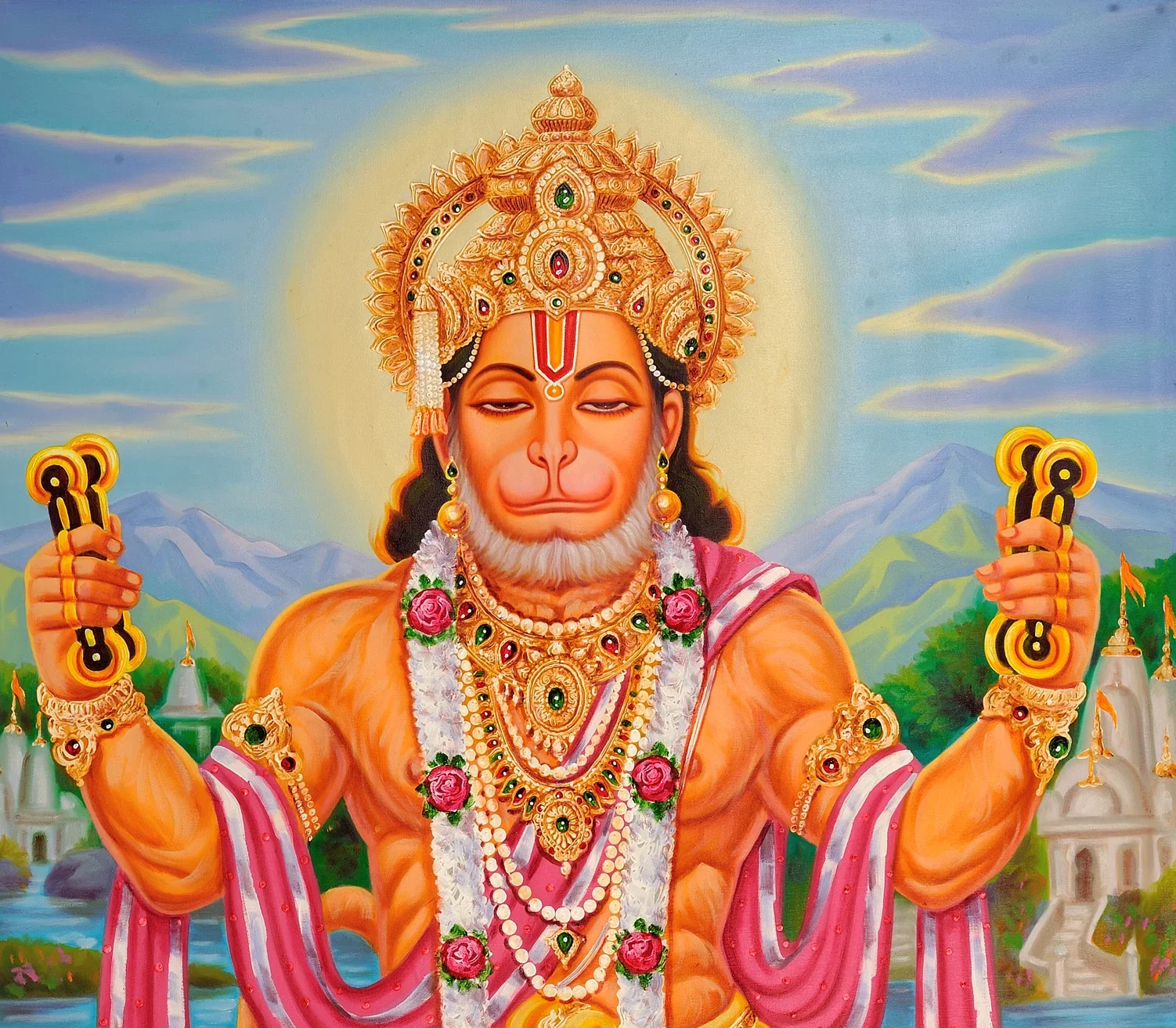
He conveys your feelings to your Ishta Devata. Just as in the material world one gets a job through recommendations, Lord Hanuman books an appointment with the deity of your heart. Many Shakta and Shaiva Sadhakas have revealed that during sadhana, they have had visions of Lord Hanuman.
Lord Hanuman is most accessible in Kaliyuga
The syllable “Hoom” in many Hanuman mantras is a fiery seed sound. The Hoom Beeja is a very fierce and special mantra to address the ferocious form of Lord Hanumanji maharaj. The Om Hoom Namah meaning is a surrender to that divine fire of purification. It dissolves inner weaknesses and energizes the seeker with spiritual vigor. When combined with “Namah,” it becomes a profound invocation to internal transformation through Lord Hanuman’s Shakti.
It is very natural. Lord Anjaneya is the most accessible deity in Kaliyuga and perhaps the most benevolent one. He is one of the eight Chiranjeevi or immortal beings. Lord Hanuman is very adorable. Also, known as Maruti, his childhood pastimes unfailingly instill wonder into the devotee’s heart.

In today’s times it is extremely important to have His blessings. Lord Hanuman is the governing deity of the Anahata chakra or the heart centre. On chanting this mantra, people suffering from insensitivity disorders start developing love and empathy. Lord Rama is the personification of Love. He is eternally present in the heart of Lord Hanuman with his consort Sita devi.
The mantra to Please Lord Anjaneya is
Om Hum Hanumate Namaha or Om Ham Hanumate Namah (ॐ हम् हनुमते नम:)
Here is the Om Hanumate Namah Mantra in English:
“Om and salutations to Hanuman, the mighty one.”
This mantra is a powerful invocation to awaken Hanuman’s qualities of strength, courage, and unwavering devotion within us. When chanted regularly with faith, it acts as a bridge between the seeker and divine support from Lord Hanuman.
Another advanced mantra is “Om Aim Hrim Hanumate Shri Ramdutay Namah.”
Its meaning is: “Salutations to Lord Hanuman, the divine messenger of Shri Rama, infused with the energies of wisdom (Aim) and spiritual power (Hrim).”
This mantra is not just a prayer, it’s a multidimensional invocation calling upon the knowledge (Aim), divine radiance (Hrim), and devotional service of Hanuman as the Ramdoot.
Initiation is Important for the Hum Hanumate Namah Mantra
But this mantra can only be chanted by initiated Sadhakas, who are under the guidance of a perfect spiritual master, who has done sadhana of this mantra, or a high class Rama Bhakta. The mantra mandates initiation and should be avoided if you are not guided by a Guru into this mantra.
A Ham Hanumate Namah Without Initiation
A Person without Initiation or a Person who is on the lookout for a genuine Guru can always Chant the “Shree Hanumate Namah” or also “Sri Hanumate Namah”. Chanting this mantra with dedication and surrendere is enough for one to attain a genuine Guru and further guidance in spiritual life.
The mantra “Om Namo Bhagwate Hanumate Namah” means: “Salutations to the Supreme Divine Hanuman.”
This mantra invokes Hanuman as an embodiment of divine force and helps in cutting through illusions, fears, and inertia. Chanting it regularly builds inner strength, clarity, and guides you toward the right Guru and path. Before we proceed to Hanuman Sadhana let us explore the Proven Maruti Yantra.
Maruti Yantra: The Embodied Śakti of Hanumān Bīja Mantras
The Maruti Yantra,also revered as the Hanumān Yantra,is not merely a symbol, but a living yantra-mūrti, a geometric embodiment of Śrī Hanumān’s divine guṇas such as bala (strength), bhakti (devotion), rakṣaṇa (protection), and adhyātma-vīrya (spiritual valor).
This potent yantra is intimately aligned with mantra-rūpa expressions like:
“Om Hum Hanumate Namaḥ”
“Kṣraum Hrīm Hrīm Hrīm Hanumate Phat”
“Om Añjaneyāya Vidmahe Mahābalāya Dhīmahi Tanno Hanumat Prachodayāt”
Each mantra is not just a chant but a nāda-bindu,a vibrational key unlocking distinct layers of Hanumān’s tattva. The yantra mirrors these sonic codes visually, becoming a mantra-dṛśya-rūpa,a form in which the sound’s resonance is held in sacred geometry.
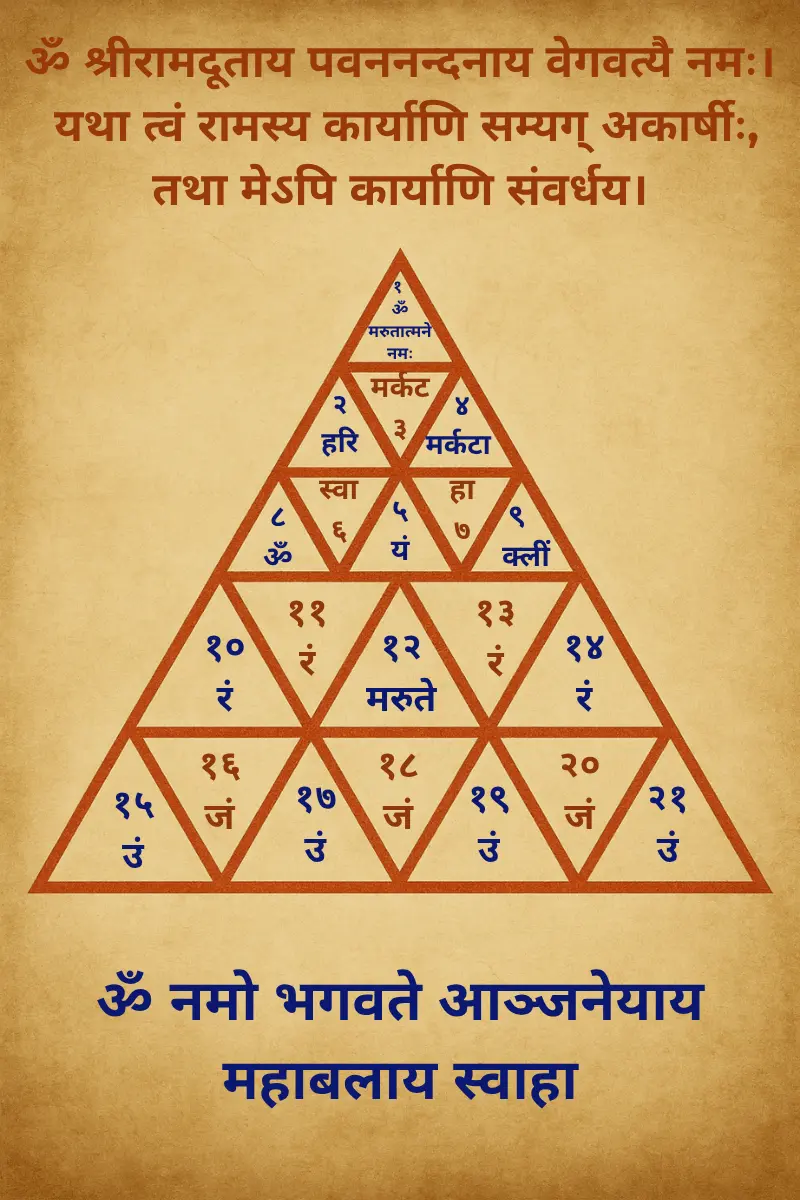
The bīja “Hum” kindles protective agni-śakti within and around. “Kṣraum” cuts through dense karmic obstacles and asuric interference. “Hrīm,” the śakti-bīja, nurtures inner purity and anchors śraddhā in the heart of the sādhaka.
Far from being a static diagram, the Maruti Yantra is a pulsating devatā-pratīka, a sākṣātkāra through which one communes directly with Hanumān. Installed on a pūjā-vedikā or carried on the person, it acts as an active śakti-anukūlaka,a medium through which divine strength, clarity, and protection are invoked into one’s life.
Maruti Yantra Phala: Divine Rakṣa, Prāṇa-Śuddhi, and Smṛti-Prabodha
The Maruti Yantra channels the anugraha of Śrī Hanumān, offering not merely symbolic protection but a tangible field of divya-rakṣaṇa that surrounds the sādhaka in times of duḥkha, rogapīḍā, and citta-vikṣepa. When worshipped with niṣṭhā and mantra-śuddhi, this yantra becomes a kavacha that shields the manas from tamasic thought patterns, bhaya, and unseen psychic interference.
Its sūkṣma-prabhāva lies in the revitalization of prāṇa-śakti. Daily dhyāna upon the yantra often leads to a quiet surge in ojas, sustained motivation, and deeper clarity in one’s svadharma. It becomes especially potent for those navigating fear, swapna-darśana doṣas (nightmares), or abhicāra (black magic), particularly when invoked through the Kṣraum and Phat bīja-mantras.
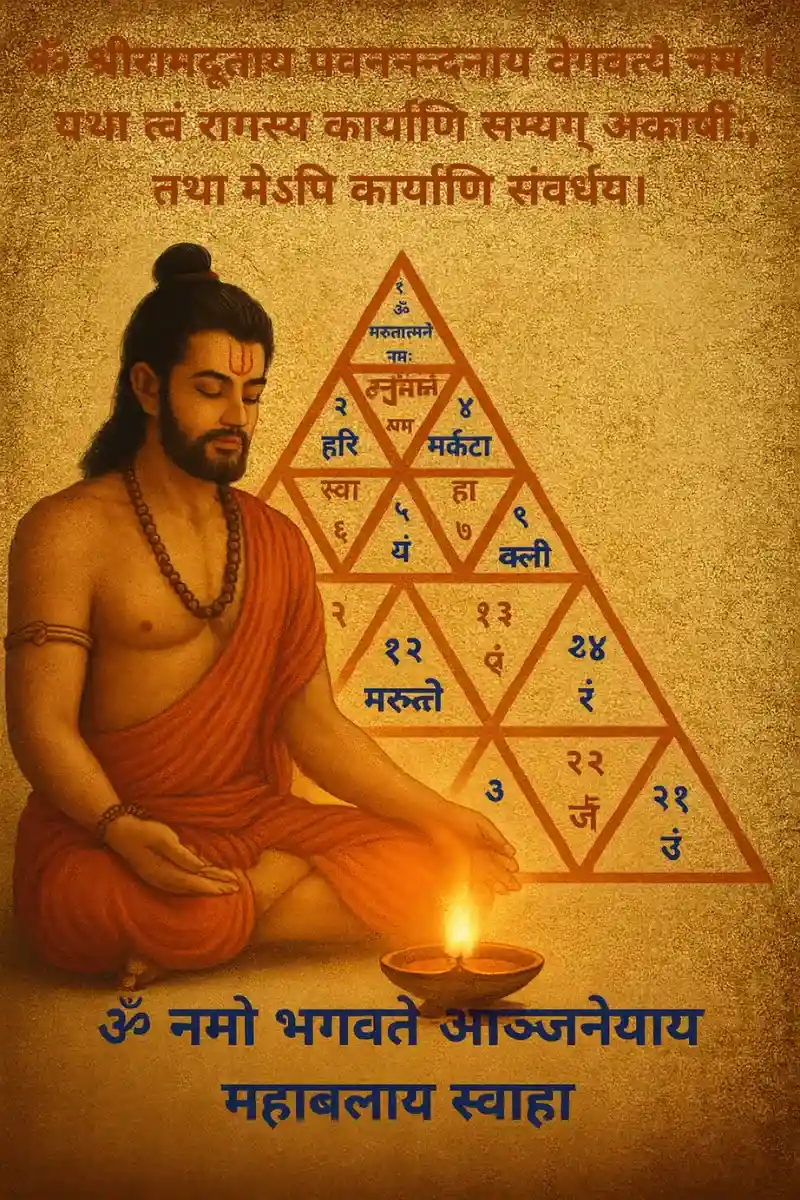
For vidyārthīs and sādhakās, the yantra awakens smṛti-śakti (divine memory) and nourishes śraddhā. Hanumān, the ādhāra of unwavering faith and jñāna-bala, imparts mental steadiness and absorption (ekāgratā) through this sacred geometry. Within the gṛhastha realm, the Maruti Yantra serves as a spiritual firewall, maintaining sanctity amidst kāla-doṣa and external disturbances.
Its influence deepens during periods of graha-peeda, especially under Śani, Rāhu, or Kuja affliction. The yantra operates as a graha-śāntikāraṇa sādhanā, harmonizing planetary turbulence and redirecting the energy towards upliftment and dhārmic realignment.
More than its external effects, the Maruti Yantra becomes a mirror to the eternal presence of Hanumān,invoking not only strength of body but the dhī, buddhi, and śraddhā to walk the path of truth with fearless love.
Maruti Yantra Racanā: Śakti-Trikoṇa, Prāṇa-Padma, and Gada-Sañketa
The Maruti Yantra is a sacred mantra-bhūmi where geometry meets divine resonance. At its hṛdaya-bindū lies the central point,bindu-sthāna,representing Hanumān-Tattva in its purest, indivisible essence. This bindu is the still axis from which strength, vigilance, and divine protection radiate outward, embodying the fearless ātmā anchored in śaraṇāgati.
From this epicenter emerge upward-facing trikoṇas,symbols of Agni-tattva, jñāna-dhāra, and ūrdhva-gati. These śakti-trikoṇas not only signify spiritual ascent but also reflect Hanumān’s mastery over the five bhūta-s and his role as a vāyuputra whose tejomaya energy burns through avidyā.
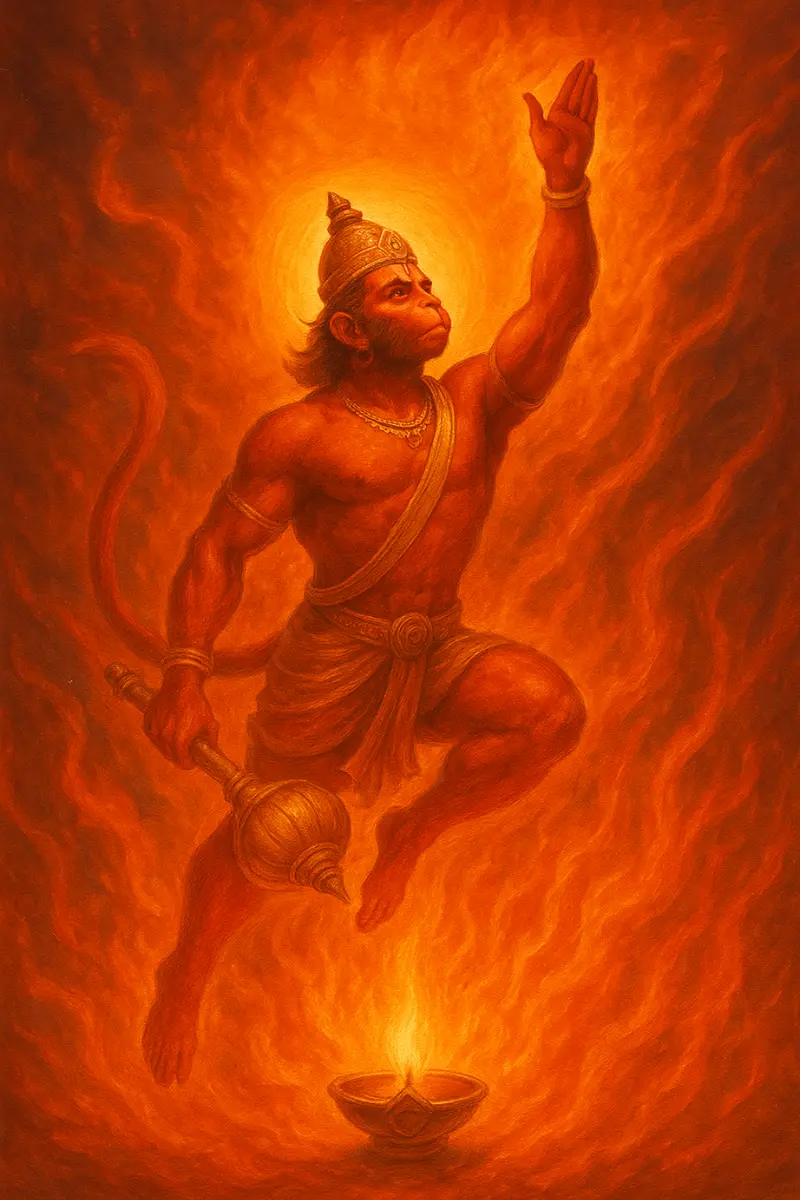
Encircling the core are 8 or 12-petaled kamala-dalas,prāṇa-cakras that mirror the subtle body’s energy vortexes. Each petal pulsates with latent bīja-akṣaras related to bala, sthāirya, and chaitanya, forging a dynamic mandala of protective and purifying currents.
Surrounding this vibrant heart is the bhūpura,a triple-lined square or angular boundary that acts as the kṣetra-rakṣaka, sealing the śakti within and demarcating the sacred from the profane. In certain lineages, subtle geometrical hints of the gadā,Hanumān’s divine mace,are encoded within the yantra through krośa-rūpa or cross-patterns, denoting the annihilation of negativity and asura-bhāva.
Though deceptively simple to the untrained eye, every angle, petal, and enclosure in the Maruti Yantra is a mantra-racanā in visual form. When infused with prāṇa-pratiṣṭhā through guru-kṛpā and mantra-japa, it begins to vibrate in harmony with the sādhaka’s nāḍī system, serving both as a bāhya-kavaca (outer armor) and an āntara-dīpaka (inner illuminator).
Maruti Yantra Gāṇita-Rahasya: Tattva-Yoga of Form, Fire, and Vibration
The Maruti Yantra is not a mere visual diagram,it is a śabda-bindu-sūtra, a sacred convergence of rūpa and nāda. Its rekhā-krama,the geometric sequencing,embodies the interplay of Agni and Vāyu tattvas, which are at the core of Śrī Hanumān’s elemental constitution. The interlocking trikoṇas channel both the fiery determination of the maṇipūra cakra and the expansive breath of the viśuddha cakra, awakening icchā-śakti and satya-vāk.
At the heart of this yantra lies the bindu,the still, luminous seed from which all directional energies arise. This bindu is no abstraction; it is a prāṇic axis, a subtle vortex that magnetizes the citta inward and propels it upward along the suṣumṇā nāḍī. Through regular dhyāna, this center refines awareness, transmuting inner turbulence into crystal clarity.
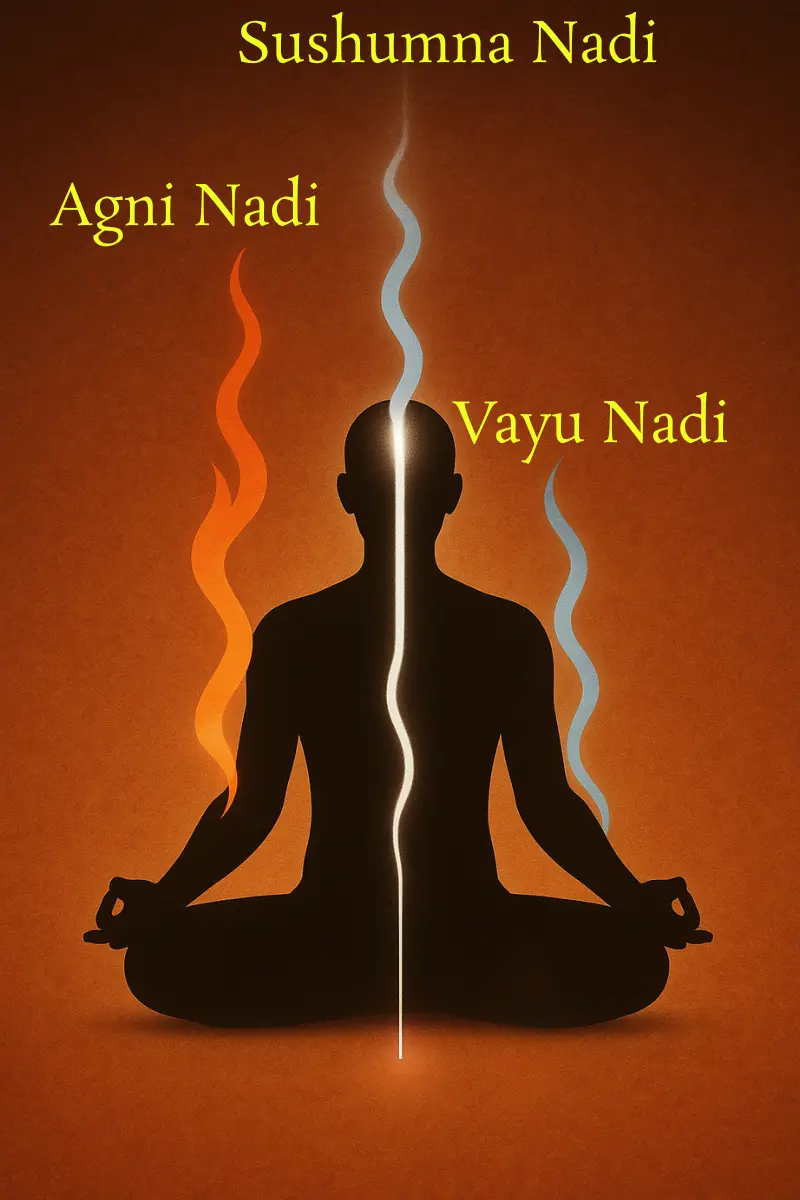
The padma-paridhi,lotus formations spiraling around the trikoṇas,generates a silent yet potent movement. Though geometrically still, they create a cakra-gati, harmonizing nāḍī-tantra pathways such as iḍā and piṅgalā. As the gaze settles into the yantra, the petals begin to pulsate inwards and outwards,revealing the movement hidden within stillness, the breath within silence.
Encasing all of this is the bhūpura,the triple enclosure that contains and consecrates. These outer lines act as vajra-kavaca, preserving the mantra-śakti within and preventing energetic dissipation. The containment is not restriction but refinement,it stabilizes the inner fire so that it may be directed, not scattered.
Many siddha-sādhakas recount that under prolonged japa, the yantra begins to turn upon itself or radiate subtle warmth. This is not an illusion; it is a śarīra-lakṣaṇa of awakened cakras and antaḥkaraṇa-śuddhi. The Maruti Yantra, when approached with mantra and Guru-anugraha, ceases to be an object. It becomes a cakra-jagrata-yantra,a dynamic presence guiding the sādhaka from fear to fearless ātma-bala.
Maruti Yantra Prāṇapratiṣṭhā: Bīja-Mantra Jāgaraṇa and Guru-Mārga Dīkṣā
To truly awaken the Maruti Yantra, one must invoke it not merely through external ritual, but through śuddha-mantra-japa,mantras resonant with Śrī Hanumān’s tattva and vibrational essence. The yantra’s geometry is a silent language until it is ignited by sound,nāda-brahma. Each bīja-akṣara acts as a key to unlock deeper dimensions of the yantra-mūrti.
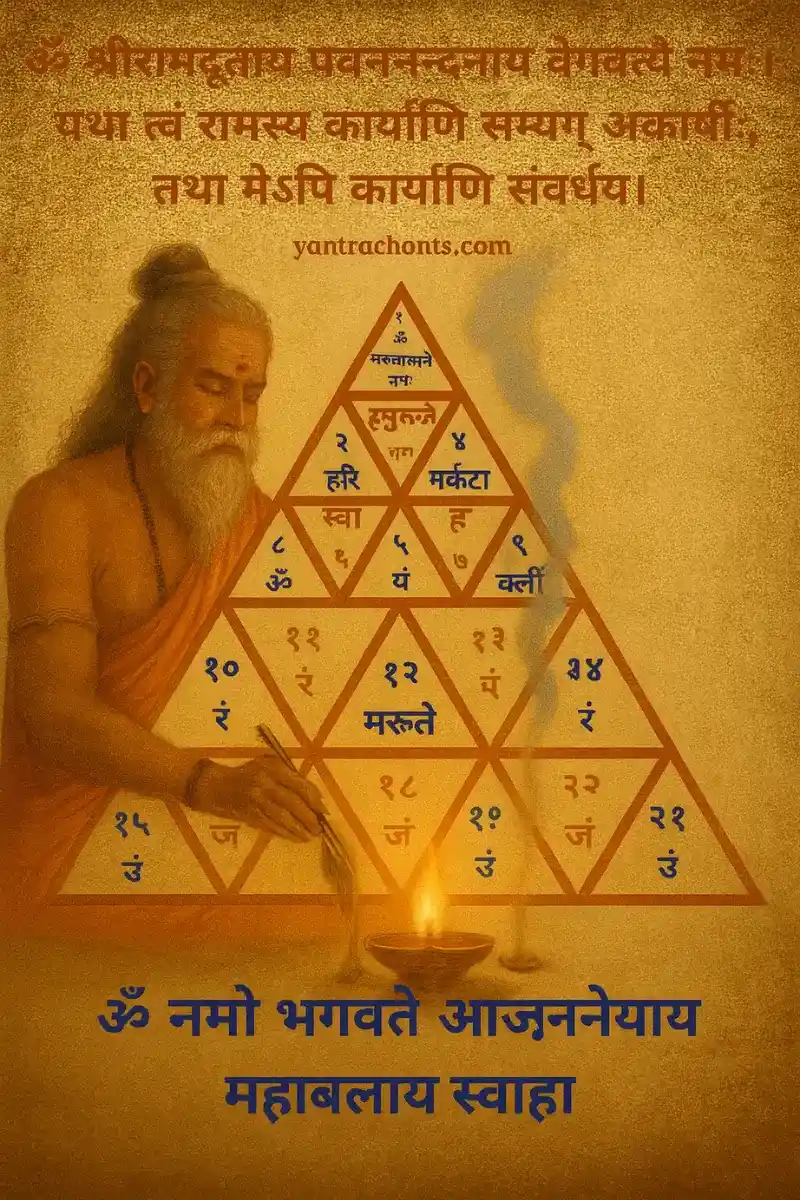
“Hum” , Vajra-bīja that invokes parā-bala, inner protection, and swiftness in karmic resolution.
“Kṣraum” , The vidyut-bīja that breaks through māyā, āvaraṇa, and inner tamas.
“Hrīm” , The śakti-bīja, purifying the antaḥkaraṇa and infusing radiant prāṇa.
“Phat” , The chedana-bīja, cutting through psychic bonds, entities, and ill-willed forces.
These can be woven together in a harmonized vibrational strand:
“Kṣraum Hrīm Hum Hanumate Phat”
For deeper prāṇic and manasika alignment, the sacred Hanumad Gāyatrī is recited:
“Om Añjaneyāya Vidmahe Mahābalāya Dhīmahi Tanno Hanumat Prachodayāt”
,A call to the eternal sevaka of Śrī Rāma, beseeching his vīrya, smṛti, and divine guidance.
Yet, these mantras are not to be used casually. They are divya-śabdas that require dīkṣā, the sanctified transmission from a jīvanmukta Guru. Without the Guru’s śaktipāta, the yantra remains dormant,its lines inert, its bindu silent. But under a realized Sadguru, the Maruti Yantra becomes a living sādhana-sahāyaka, mirroring Hanumān’s own qualities: unwavering śraddhā, niṣkāma-karma, and the śakti to transform fear into fearless devotion.
Maruti Yantra Nirmāṇa-Vidhi: Tantra-Lakṣita Sraṣṭṛkarmā at Yantrachants.com
At yantrachants.com, the creation of each Maruti Yantra is not a mechanical task but a sacred sṛṣṭi-kriyā, rooted in paramparā, purity, and inner tapas. Every yantra is manually inscribed,either on Bhojapatra (sacred birch bark) or engraved on high-conductivity tāmrapaṭṭa (copper plates),using sindūra-rakta lepa, kesarāṅka, or ghṛta-lehya inks, each chosen in accordance with specific ācāra and sampradāya. The design adheres precisely to Vaiṣṇava-Tāntrika geometry aligned to Śrī Hanumān’s sūkṣma-śarīra mapping.
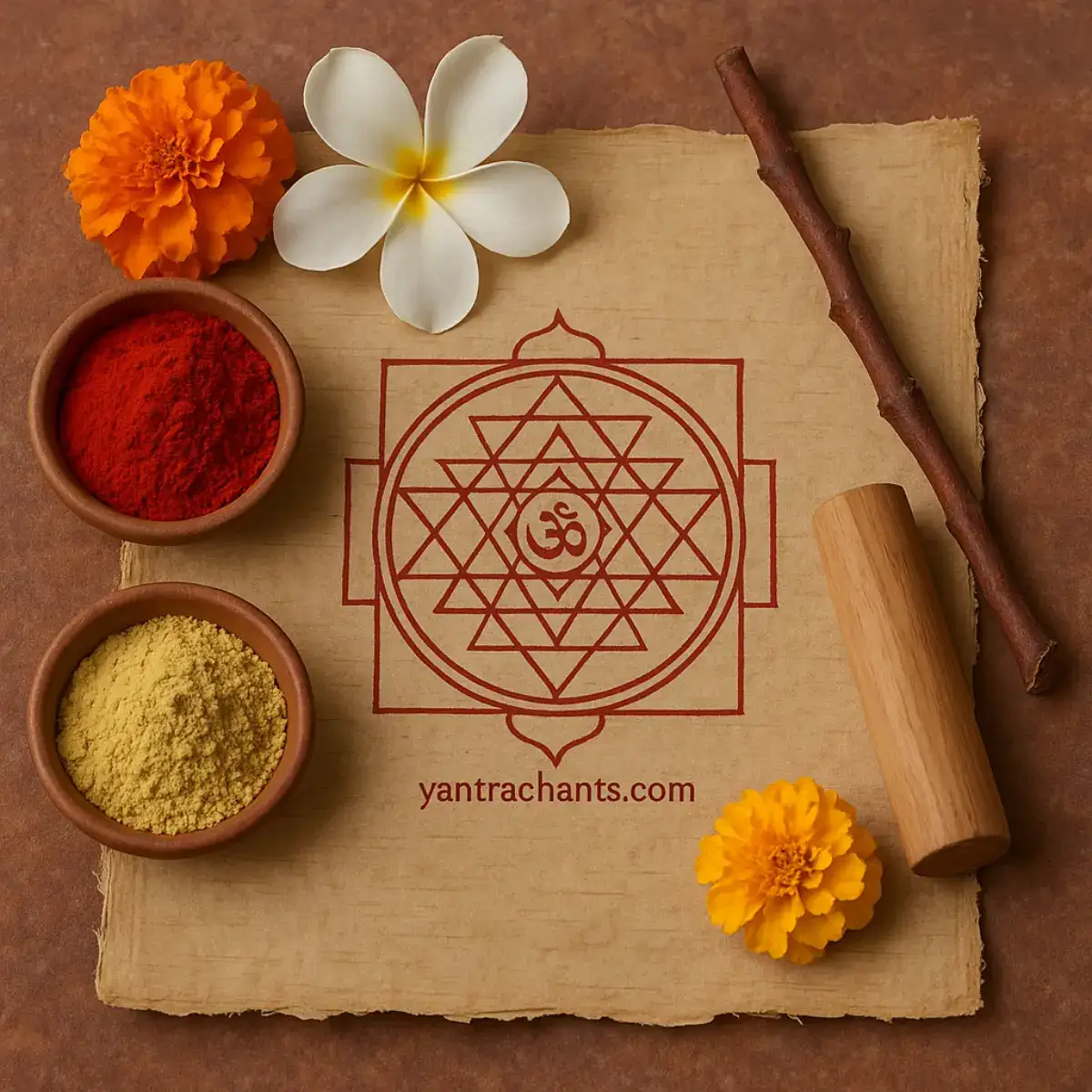
The sampuṭa-vinyāsa of this yantra begins during auspicious graha-muhūrtas,most often on Maṅgala-vāra (Tuesdays), Amāvasyā, or Hanumān Janmotsava tithis. Before any inscription, Vedic saṃskāras are conducted to purify the yantra medium,jala-śuddhi, agni-śuddhi, and mantra-śuddhi rituals sanctify the base.
Guided by a living Sat-guru belonging to an unbroken dīkṣā-paramparā, the bīja-mantras and Hanumad Gāyatrī are chanted in nāda-laya, with full bhāva and niyama, anywhere from 11,000 to 21,000 times. This japa-tapas is not symbolic,it is the very breath that breathes life into the yantra’s racanā.
Once the chanting is complete, the yantra is placed within a consecrated maṇḍala, surrounded by daivika dravyas,tulasī-dalas, guggulu-dhūpa, and rare sanctified herbs. Offerings of urad-dāla, tila-taila, and guda are made to honor Hanumān’s bhojana-svarūpa, invoking his living presence within the sacred geometry.
There is no automation. No mass production. Each yantra is a pratibhā-mūrti,a luminous expression of devotion, austerity, and Guru-śakti.
The culmination is the prāṇa-pratiṣṭhā,the sacred transmission of jīvana-śakti from Guru to Yantra. Through this final act, the Maruti Yantra becomes jīvat-yantra,a conscious ally, ready to respond to the sādhaka’s intent, protect the subtle body, and mirror Hanumān’s eternal sevā-bhāva in the practitioner’s life.
Sat-guru-Saṅkalpaḥ: The Causal Flame Behind a Jīvanta Yantra
No yantra,however intricately drawn or ritually consecrated,can awaken into full potency without the sannidhi and anugraha of a jñānī-svarūpa Sadguru. The Guru is not merely an instructor in outer rites but the daiva-dvāra,the gateway through which the icchā-śakti of the Divine enters the plane of the seeker’s karma. It is the śakti-saṅkalpa of such a tattvadarśī Guru that transforms geometric ink into a living presence of the Devatā.
A self-realized Guru does not just activate the yantra,they tune it. They match the yantra’s cakra to the seeker’s sūkṣma-śarīra, subtly aligning it with the rhythm of one’s prārabdha, vāsanās, and adhyātma-mārga. Just as Śrī Hanumān never acted independently but always as the servant of Rāma’s will, the sādhaka too must walk in the chāyā of the Guru’s light.
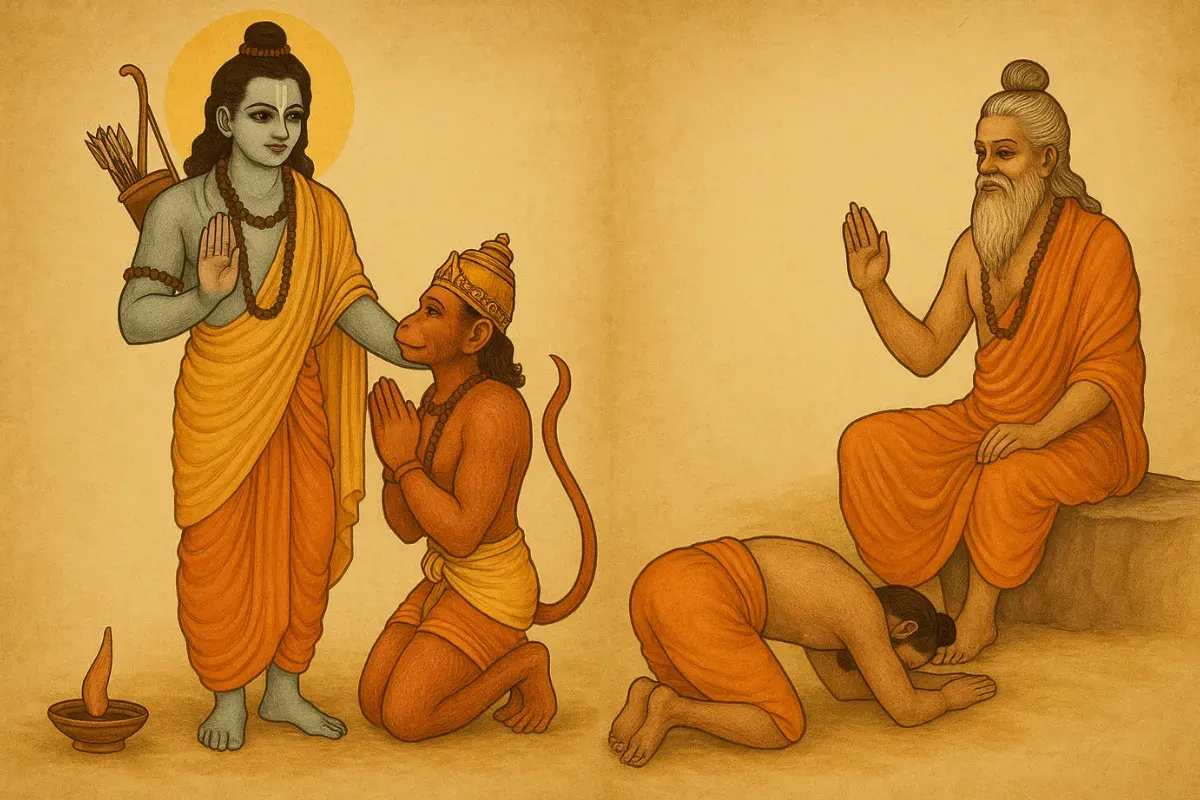
The Guru’s sparśa,physical, vibrational, or subtle,infuses the yantra with caitanya. What was mere copper or bhojapatra becomes a devatā-mūrti, aware, responsive, and fiercely protective. The bindu begins to pulse, the rekhās begin to breathe, and the prāṇa of the sādhaka finds a mirror in the yantra’s garbha.
It is through the Guru that the yantra can vākyārtha-bodha,speak when danger is near, protect when energies clash, and guide when the path grows dim. Without this tuning, the yantra remains a dormant śilpa. But through the Guru’s prāṇa-pratiṣṭhā, it becomes a spiritual darpaṇa, reflecting the sādhaka’s śaurya, śraddhā, and inner dharma.
Thus, the Sadguru is not optional,they are the yoni from which the yantra-jīvana is born. You may read our article on Narasimha Yantra to call upon the fierce protector who destroys injustice in an instant.
Gupta Lakṣaṇāni: Subtle Manifestations and Rare Śākṣātkāras of the Maruti Yantra
Those who install and pariśodhita-pūrvaka energize the Maruti Yantra often witness uncanny shifts that defy rational explanation yet feel deeply intuitive. Devotees report vivid svapna-darśanās involving vānara-svarūpas, rushing winds, or shimmering rakṣā-kavacas,symbols long associated with Śrī Hanumān’s unseen protection.
During heightened japa-kāla, particularly when the manipūra or anāhata cakra is engaged, sādhakas often feel intense warmth or a surge of subtle vibration,a clear marker of prāṇa-jāgaraṇa. These are not imagined phenomena but antar-lakṣaṇas of inner energetic alignment.
In some sacred spaces, the air around the yantra feels palpably altered,like a silent sākṣin is watching with benevolence. Devotees recount instances where seemingly immovable obstacles dissolve or hostile forces withdraw shortly after placing an awakened Maruti Yantra in the home.
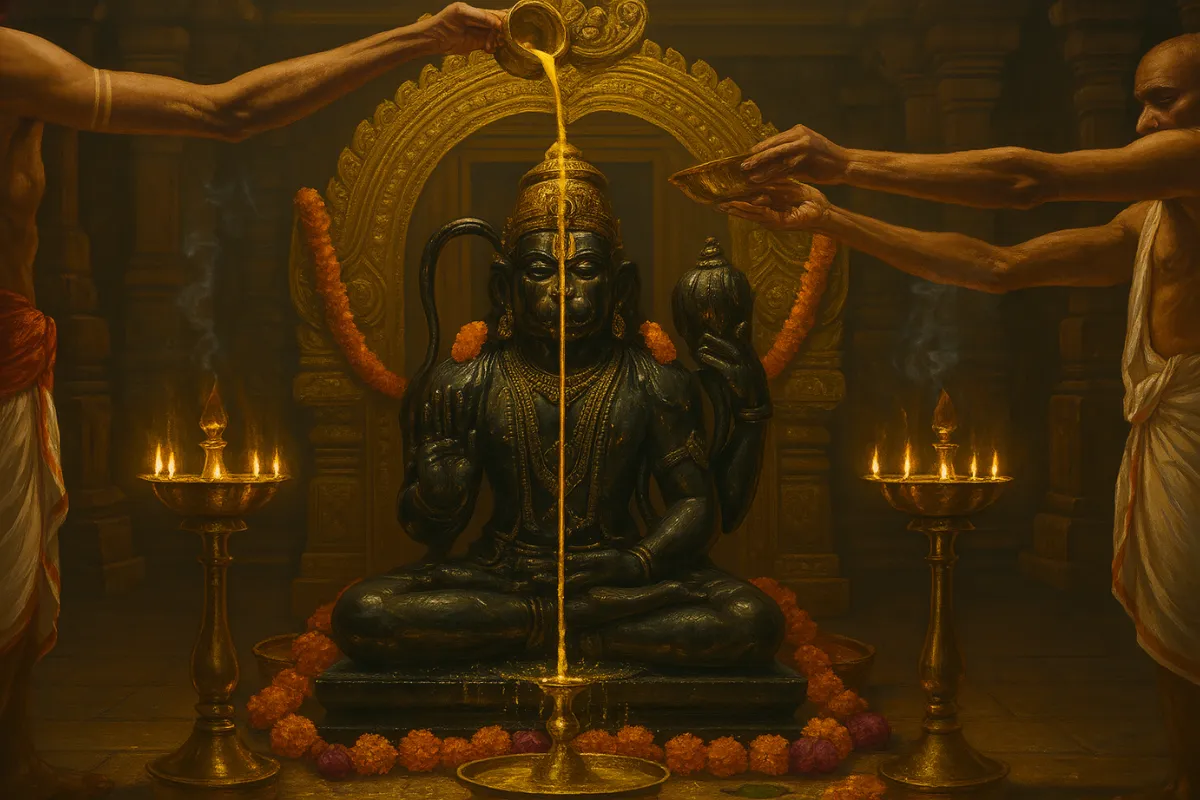
Its tejas intensifies during Maṅgala-vāra (Tuesdays), Hanumān Jayantī, or Amāvasyā nights. Lighting tila-taila dīpas near the yantra while chanting “Kṣraum Hanumate Namaḥ” magnifies its rakṣā-śakti, casting a potent field of bhūta-pratibandha-vināśa.
It is also observed as a powerful pariśodhana-upāya for persistent asubhāva, vyāpāra-bādha, legal entanglements, or graha-doṣa,especially linked to Śani and Rāhu. The yantra, when approached with sincerity and under Guru-anugraha, ceases to be an object,it becomes Hanumān-Tattva itself, living and luminous.
Hanumān-Bhakti-Tattvaḥ: The Maruti Yantra as a Mirror of Śaraṇāgati and Sevā
Śrī Hanumān is not a deity of occult dominion, but the mūrti of niṣkāma-bhakti, dāsya-premā, and unshakable dharma-niṣṭhā. He is not worshipped for siddhi or control, but for śaraṇāgati,total inner surrender to the Divine Will. The Maruti Yantra, in this light, is not a device of power but a sacred portal of bhakta-caitanya, meant for those who seek not domination but service.
This yantra does not respond to ambition,it responds to śraddhā and sevā-bhāva. It is the invisible kāruṇya-hasta of Hanumān, stretching out to those who invoke him with sincerity. A child’s trembling cry, a mother’s wordless prayer, or a seeker’s quiet invocation,all reach him faster than any elaborate vidhi without bhāva.
When installed and approached with love, the Maruti Yantra becomes an inner jñāna-darpaṇa,reminding the sādhaka to walk with vinaya (humility), vīrya (courage), and niyama (discipline), all under the umbrella of Divine remembrance.
To walk with Hanumān is to walk the path of dāsya, not for gain but for yogya-sevā. He is the breath of fearless devotion, and the yantra becomes his subtle footprint, quietly guiding the seeker toward a life of simplicity, protection, and unwavering love for the Paramātmā.
Satvik Lifestyle is mandatory for Hanuman Sadhana
The benefits of the Om Hum Hanumate Namah mantra (Om Hum Hanumate Namah mantra ke fayde ) are immense. It purifies the aura, strengthens your heart chakra, and draws protective energies around you. This mantra is often recommended for those going through major life shifts, obstacles, or loss of direction. With proper guidance, it becomes a life-transforming chant.
A deeper paraphrased meaning of the mantra is- I pray to Lord Hanuman, to bless me with devotion, strength, victory, success and power. This mantra is so powerful that it compels Lord Anjaneya to give darshan.The darshan and fiery aspect of Anjaneya can be disturbing, if you are not celibate and do not have a Guru. It may cause mental hallucinations, if proper rules are not applied and one is not living a Satvika lifestyle.

Hanumanji’s aura is too fiery. Indeed, the sun god imparted one-hundredth of his brilliance to Lord Hanuman. In His childhood, Lord Anjaneya swallowed the sun god.Imagine the intensity of his energy. The Om Hum Hanumate Namah mantra gives one the power to experience the fiery energy of Lord Anjaneya. Do not take this mantra lightly. Chant it under the guidance of a self-realized guru only.
Another sacred mantra is Ramaya Hanumate Namah, which offers a beautiful blend of invoking Lord Rama and his eternal servant Hanuman. The benefits include deepening devotion to both, gaining spiritual merit, and receiving insights on how to live a dharmic life with love, loyalty, and fearlessness.
Chanting Om Han Hanumate Namo Namah 108 times brings immense benefits. It helps you overcome fatigue, fear, and emotional blockages. Repeating this 108 times daily aligns your subtle body with Hanuman’s vibration and brings focus, determination, and courage, especially during Saturn’s difficult transits.
Besides, many Sadhakas have complained that after chanting this mantra they have got high fever and are unable to handle the energy.A guru here acts like a shield and filters the excessive energy.
The Many Benefits of the Anajaneya Mantra
Let’s look at the Om Shri Hanumate Namah Mantra benefits. This sacred chant invokes the pure form of Hanuman without invoking his fiery Rudra aspect. It is ideal for householders and beginners, promoting calm strength, emotional resilience, and divine protection without overwhelming the nervous system.
Now I shall state the benefits of chanting Om Hum Hanumate Namah.The Anjaneya mantra drives away fear and brings renewed energy in life. You become a problem-solver. Chanting this mantra on Tuesdays and Saturdays lessens the bad effects of Shanidev as He is an ardent devotee of Lord Anjaneya.
If you stumble upon a problem, the Hanuman mantra triggers your brain giving you wonderful ideas. He also fights against spirits causing disturbance in your life. Mehendipur Balaji in Rajasthan removes the spell of black-magic and the fear of ghosts.
The Om Namo Hanumate Namah mantra is a gentle yet powerful prayer that acts like spiritual armor. Its benefits include shielding against black magic, increasing spiritual intelligence, and creating favorable energies around your home and relationships. It’s highly effective when chanted with a clean heart in the Brahma Muhurta.
The flower of bhakti blooms as Lord Anjaneya is Bhakt Shiromani. You shall turn out to be unexpectedly confident and shall take life-changing decisions. This Hanuman mantra brings peace of mind driving away all the negative forces that disturb your mental balance. He has the power to grant Ashta Siddhis.
These are just a few benefits that I have mentioned.
The complete Hanuman Sadhana benefits go beyond just protection or strength. It rewires your nervous system to become more grounded, helps in resolving karmic entanglements, and builds fearlessness. Many sadhakas report clarity of purpose, faster decision-making, and divine guidance emerging during or after sincere Hanuman sadhana.
Start Hanuman Sadhana as per the rules and see the benefits for yourself, of course under the instructions of a perfect Guru. Lord Hanuman’s meditation instills an orange ambience around you. While chanting the mantra visualize Lord Rama as he is the Ishta Devata of Hanumanji.
The advanced mantra Om Han Hanumate Rudratmakaya Hum Phat awakens the fierce protector aspect of Hanuman. Its benefits include eliminating deep-rooted fears, breaking spiritual blockages, and removing astral disturbances. However, this mantra should only be used under expert guidance, especially during tantric or planetary crisis periods.
Chanting Rama Nama aids the Anjaneya Mantra
A simple and sattvic mantra is Om Sri Hanumate Namah. This version is very calming and perfect for daily practice. It promotes bhakti, steadiness, and peace in the home. It also harmonizes relationships and invokes Hanuman in his loving, childlike form.
It is advised to chant Rama mantra when you chant the Anjaneya mantra. Hanumanji Maharaj is eternally present with those who recite Rama Nama. More than chanting his own name he relishes hearing Rama Nama. Wherever there is Rama Katha, Lord Hanuman sits patiently and hears it.
Here is the Om Namo Hanumate Mantra in English:
“Salutations to Lord Hanuman, the source of divine strength and protection.”
This mantra when translated gives a clear invocation of protection and support. It helps one stay rooted in dharma and allows the mind to stay free from external noise during spiritual practice.
I advise you to chant one round of Sri Rama Jai Rama Jai Jai Ram mantra before starting Hanuman sadhana. There is no initiation required for this Rama mantra because it falls under the category of Nama mantra.
Chanting Om Namo Hanumate Rudravataraya Mantra gives rise to Hanuman’s Rudra form, bringing fiery purification, rapid detachment from negativity, and divine strength. Its benefits are especially useful during spiritual warfare, intense Saturn phases, and when seeking quick resolution of life-threatening or legal issues.
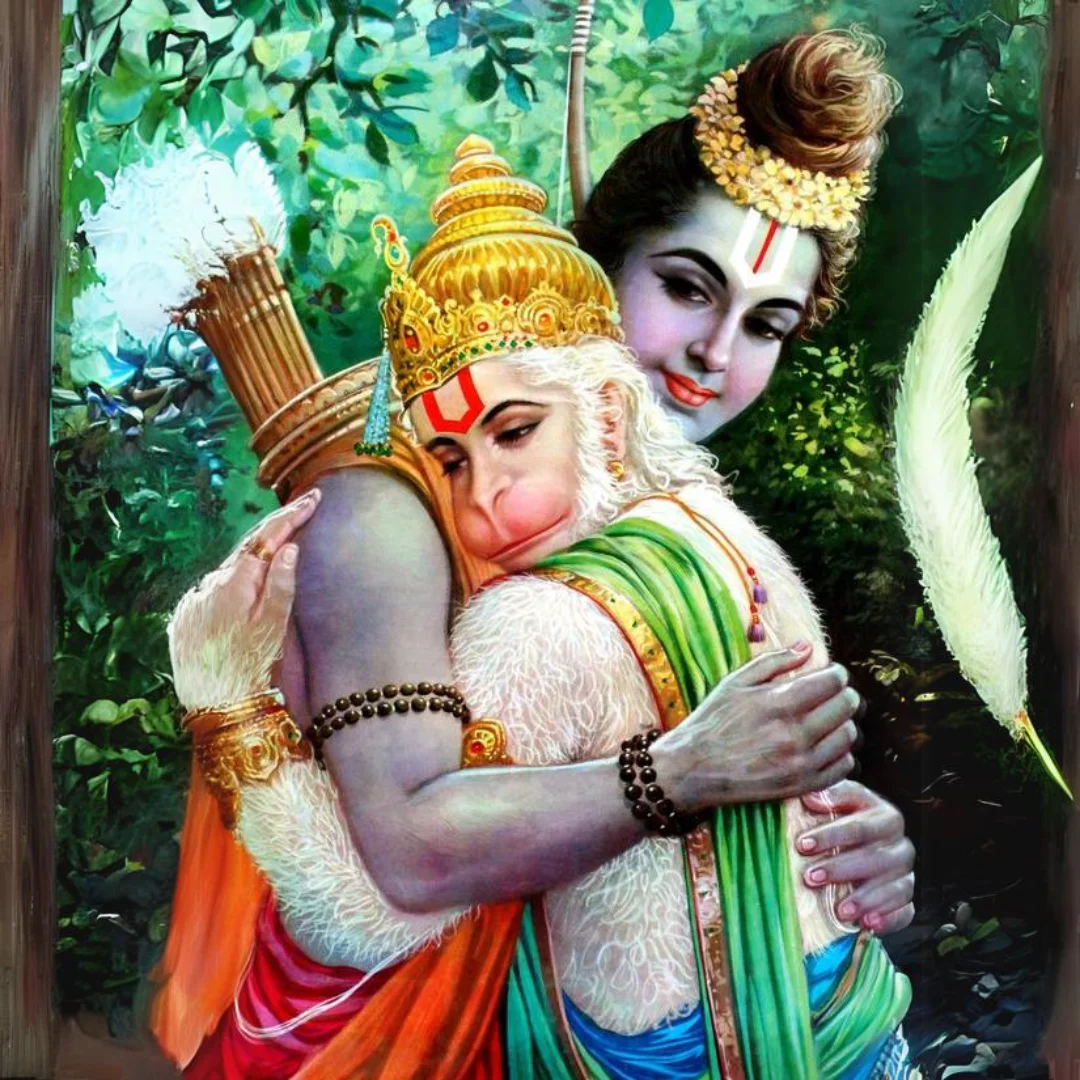
If you chant the Sri Ram Jai Ram Mantra, you can get a Guru who will be able to initiate you into the Om Ham Hanumate namah.
Other Precautions and Rules in Anjaneya Sadhana
You can use Rudraksha mala or Coral mala to chant this mantra. Above all, you must follow rules. Maintain purity of mind and body. It is compulsory to observe brahmacharya during Hanuman Sadhana. Keep your body and mind clean, following the path of Truth or Satya.
The lesser-known mantra Om Pingaksha Namah honors Hanuman in his blazing-eyed form. Its benefits include enhanced third-eye perception, better insight into hidden situations, and warding off jealous or envious energies. It is highly effective during sadhana for insight, clarity, and energy field purification.
The powerful mantra Om Hum Om Hum Hreem combines fire and divine radiance. Its benefits include aura expansion, protection from unseen energies, and strengthening the subtle body during spiritual practice. When used before advanced Hanuman mantras, it helps stabilize energy currents and calms mental disturbances.
The Hum mantra by itself is a bija (seed) syllable of divine fire. Among the most powerful seed sounds in tantric sadhana, it incinerates fear and self-doubt. Hum mantra benefits include strengthening your pranic field, enhancing protection, and awakening willpower, especially when used before chanting Hanuman mantras.
Om Hreem Hum Namah is a bija mantra blend invoking spiritual power and fire. Its benefits include cleansing subtle body blocks, protecting from psychic interference, and strengthening willpower. It can be chanted as a preparatory mantra before invoking Hanuman to harmonize your energy field.
Light incense sticks and keep the ambience fragrant. You can take a sankalpa of 11 days, 21 days or 41 days. Keep away from addictive substances such as smoking, drinking, tobacco and non-vegetarian food. You should possess the qualities of the deity you are worshiping.
The Hum Hanumate Rudratmakaya Hum Phat mantra channels intense Rudra energy through Hanuman. Its benefits include immediate breaking of mental tamas (inertia), clearing dark attachments, and energizing subtle centers. However, it must be approached with humility, strict celibacy, and a clean heart.
One of the simplest and most direct chants is Om Hanumate Mantra. It can be used daily to maintain connection with Hanuman’s blessings. Whether spoken mentally or aloud, it builds a steady bond with divine assistance, improves vitality, and brings a sense of inner stability even during crisis.
When chanted with devotion, Om Namo Bhagavate Hanumate Namah bestows deep spiritual protection. The benefits include removal of chronic fears, psychic disturbances, and sudden health issues. It is also recommended for those facing spiritual stagnation or looking to begin new ventures under divine blessings.
The mantra Om Aim Bhreem Hanumate Shri Ramdutay Namah is a rare jewel.
In English, its meaning is: “Salutations to Hanuman, the messenger of Rama, imbued with the energies of wisdom (Aim) and divine will (Bhreem).” Its benefits include sharpening intellect, accelerating spiritual growth, and opening the devotee’s heart to divine obedience and dharma.
This is mandatory. Follow non-violence and do not intend to hurt even the tiniest of creatures. If you do not have a guru, consider Lord Shiva as Vishwa Guru and chant one round of Namah Shivaya mantra also, without the chant of OM. But remember, for self-realization/ God-realization having a living Guru with a physical body is non-negotiable.
Only a person with a physical Guru, a Sat-Guru alone can reach the ultimate destination of Bhagawat Prapti. Because having a real physical Guru, shall help in pulping the hard shell of Ego, which cannot be removed through “assuming” Bhagawan itself as your Guru. It shall help in a very small way but cannot sail you through the hard dry rocky desert of the Individual Ego.
Om Aim Hreem Hanumate Shri Ram Dutay Namah is a multidimensional mantra that balances knowledge and spiritual force. Its benefits include better discernment in spiritual matters, calming of internal conflict, and invoking Hanuman’s assistance as Ram’s loyal messenger during periods of confusion or loss of faith.
Om Namo Hanumate Rudravataraya Mantra literally means: “Salutations to Lord Hanuman, the fierce avatar of Rudra.”
In English, it expresses surrender to Hanuman in his Rudra incarnation, the fiery protector. This mantra is ideal for destroying enemies, removing black magic, and shielding one’s home or aura from dark energies
Strengthen your spirit with Hanuman’s unshakable devotion. Request this yantra for divine support in your toughest trials.

Vani Devi Dasi

